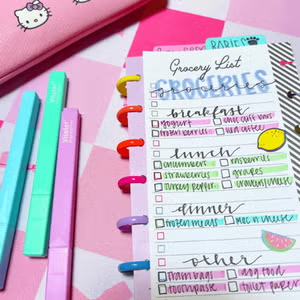Your Ultimate Guide to Building a Healthy Grocery List That Actually Works
Take the Stress Out of Grocery Shopping with These Budget-Friendly Tips & Templates

Let's talk about the ice cream aisle incident. You know, the one where you walk into Target for toilet paper and somehow end up with three pints of Häagen-Dazs and zero actual necessities. We've all been there, standing in our kitchen at 9 PM wondering how our good intentions got derailed somewhere between the produce section and checkout.
Grocery shopping is deceptively hard. It seems straightforward (go to store, buy food, eat food), but throw in marketing tactics, hunger, and about seventeen different types of milk alternatives, and suddenly you're paralyzed in the dairy section and reaching for an easy fix (aka some processed microwave meal).
A study published in the Journal of Nutrition Education and Behavior found that people who consistently use shopping lists have healthier diets and lower BMIs compared to those who wing it. Which honestly makes total sense when you think about it. Walking into a grocery store without a plan is like trying to navigate Los Angeles without GPS—technically possible, but why would you do that to yourself?
We’ll break down what actually belongs on a healthy shopping list, share some budget tricks that don't involve living off rice and beans, and give you templates you can actually use. Plus, we'll cover when to call in reinforcements, because sometimes you need someone else to do the thinking for you. (Image credit: @outplayedbyjade)
All products and deals are sourced by the Rank & Style team using data and expert insights. If you shop through our links, we may earn a commission—at no extra cost to you.
Building Your Healthy Eating Grocery List Foundation

@msdlifestyle
Contrary to many influencers, you don't need exotic superfoods or supplements that cost more than your rent to eat healthy. You need real foods that taste good and make you feel good.
Produce Power Players
Dark greens like spinach pack more nutrients per bite than almost anything else, but if you're going to let them rot in your crisper drawer, maybe start with bell peppers or cucumbers instead. Berries are antioxidant superstars. Avocados are a fan favorite for good reason—they're creamy, satisfying, and full of the good fats your brain craves.
Fresh is great when you'll use it within a few days. Frozen is great when you won't. Canned works too, just check the labels—fruit should be in its own juice, vegetables should skip the added sodium. Don't overthink it.
Protein That Actually Appeals
Greek yogurt is protein-packed and works for breakfast, snacks, or sauce bases. Eggs are cheap, versatile, and nearly impossible to mess up. Beans and lentils might sound boring, but they're nutritional and budget-friendly. If you eat meat, rotisserie chicken is your friend. Someone else did the cooking, and you get protein for days.
Mix it up. Chicken gets boring eventually, fish is a healthy way to shake things up, and plant proteins like tempeh or tofu can be delicious when you season them properly. Canned fish counts and lasts forever in your pantry.
Carbs That Won't Crash You
Brown rice, quinoa, and oats have fiber that keeps you full instead of sending your blood sugar on a rollercoaster. Whole grain bread should have at least 3 grams of fiber per slice.
Fats Worth Eating
Olive oil, nuts, seeds, and fatty fish aren't just trendy—they're essential for hormone production and brain function. Don't fall for the fat-free trap from the '90s.
Pantry Essentials
This is where the magic happens. Good pantry staples mean you can throw together a decent meal even when your fridge looks sad. Stock up on things like canned beans, whole grain pasta, nuts, seeds, and spices that can bring flavor to whatever you have on hand.
Dairy and Alternatives
The yogurt aisle is overwhelming. A healthy way to cut decision fatigue is to pick plain versions and add your own fruit. Most flavored varieties are basically dessert disguised as health food, with a lot of added sugar. For milk alternatives, soy has the most protein, but use whatever you like best.
Snacks That Don't Sabotage
Try vegetables with hummus, nuts, fruit, or yogurt with berries. Don’t fall into the empty calorie potato chip trap. These options have nutritional value, and will help keep you full longer. (Image credit: @msdlifestyle)
Understanding the Produce Rainbow
.png?width=300)
rank & style
Each color of fruits and vegetables is linked to specific nutrients and health benefits.
Red = Heart Health & Cancer-Fighting Antioxidants
Red produce is high in lycopene and anthocyanins, which help protect cells from damage and support heart health, prostate health, and decrease the risk of breast cancer.
Examples: tomatoes, red bell peppers, strawberries, watermelon, cherries.
Orange = Eye Health & Immune Support
Orange produce is rich in beta-carotene, which your body turns into vitamin A. That helps your eyes, skin, and immune system.
Examples: carrots, sweet potatoes, oranges, butternut squash, pumpkin, cantaloupe
Yellow = Skin Health, Digestion & Energy
Yellow foods often contain vitamin C, flavonoids, and lutein, which support collagen production, digestion, and brain function.
Examples: bananas, corn, pineapples, yellow bell peppers
Green = Detox & Bone Health
Greens are packed with chlorophyll, folate, lutein, vitamin K, and indoles, which help with detoxification, blood clotting, and reducing cancer risk.
Examples: spinach, broccoli, kale, Brussels sprouts, avocados, green beans, kiwi
Blue & Purple = Brain Health, Memory & Anti-Aging
These contain anthocyanins and antioxidants, which are associated with improved brain health and memory. They also help lower blood pressure and reduce the risk of stroke and heart disease.
Examples: blueberries, blackberries, eggplant, purple cabbage, plums
White & Beige = Immunity & Anti-Inflammatory
These foods are often rich in allicin and potassium, which support immune function, heart health, and may lower cholesterol.
Examples: garlic, onions, cauliflower, mushrooms, potatoes, ginger
Healthy Swaps That Actually Work

rank & style
The easiest way to upgrade your diet isn't eliminating everything you love—it's finding better versions of the foods you already crave. These simple swaps give you the satisfaction you're looking for while sneaking in extra nutrients and keeping you fuller longer. The best part? You won't feel like you're missing out on anything.
Chips → Popcorn (more volume, less guilt)
Ice cream → Greek yogurt with honey and berries (Same creamy satisfaction + protein and probiotics)
Candy → Dark chocolate squares (Antioxidants and portion control built-in)
Cookies → Apple slices with almond butter (Fiber meets healthy fats for lasting energy)
Your Flexible Healthy Grocery List Template

@planwitharri
Here's a flexible framework that adapts to your actual life. The key is treating this as a template, not a rigid rulebook—swap categories based on what's on sale, what you actually like, and what fits your schedule that week. Think of it as your grocery shopping GPS: it'll get you where you need to go, but you can take detours when life happens.
Protein Sources (Pick 2-3 for the week):
- Choose options you actually like: chicken, fish, eggs, beans, Greek yogurt, tofu
- Buy enough for 5-7 meals depending on your household size
Vegetables (Aim for 4-5 different types):
- Pick at least one from each color category if possible
- Buy pre-cut if lack of time keeps you from preparing veggies
- Choose frozen if you're worried about spoilage
- Plan for 2-3 cups per person per day
Fruits (Choose 3-4 varieties):
- Mix of fresh and frozen works great
- Aim for 1-2 cups per person per day
- Skip dried fruits with added sugar
Whole Grains (Stock 2-3 staples):
Brown rice, quinoa, oats, whole grain bread
Buy quantities that last 1-2 weeks
Healthy Fats (Keep these basics on hand):
- Good olive oil, nuts or nut butter, avocados
- These last longer so you can buy in larger quantities
Pantry Essentials (Restock as needed):
- Canned beans, low-sodium broth, herbs and spices
- Condiments that make vegetables taste good to you
Real-Life Shopping Lists
- Busy Professional:
Rotisserie chicken, pre-washed greens, microwaveable brown rice, frozen vegetables, Greek yogurt, bananas, coffee - Family Mode:
Ground turkey, pasta, marinara sauce, frozen vegetables, apples, milk, string cheese, whatever keeps the kids fed - Student Budget:
Eggs, oats, peanut butter, bananas, dried beans, frozen vegetables, rice, whatever's on sale
(Image credit: @planwitharri)
Meal Planning Without the Drama
Forget elaborate meal planning systems that require spreadsheets and color-coding. Think about ingredient overlap instead. Buy chicken thighs, and you can make tacos Monday, stir-fry Wednesday, and soup Friday. One bag of quinoa becomes grain bowls, salad toppers, and soup filler.
Theme nights eliminate decision fatigue. Meatless Monday, Taco Tuesday, whatever works for your family. It's structure without being restrictive.
When Meal Planning Feels Impossible
Some weeks are just like that. If you’ve reached the point where you need a little extra help, check out meal kits. They do the shopping, portioning, and some of the prep work, and you just need to put it all together.
Home Chef and Blue Apron send you pre-measured ingredients with super straightforward instructions. Hungryroot curates groceries based on your preferences and dietary restrictions, and Factor is perfect if you want to heat and eat meals on hand. Sometimes convenience wins, and that's okay.
Budget-Smart Shopping
Let's address the elephant in the room: groceries feel outrageously expensive these days. The wellness industry doesn't help, constantly pushing the idea that you need premium everything to be healthy. Truth is, most of that is marketing designed to separate you from your money. Let’s break down some strategies to help you get more for your money at the grocery store.
Generic vs. Name Brand: Store brands are often manufactured in the same facilities as name brands, just with different packaging. The quality difference is usually negligible, so save your money for items where it actually matters, like high-quality olive oil or wild-caught fish when it goes on sale.
Thrive Market offers wholesale pricing on organic and natural products, making healthier options more accessible without the typical premium markup. Amazon Fresh lets you compare prices across brands and save your frequently purchased items for quick reordering, which helps you stick to your budget and avoid impulse buys.
Seasonal Shopping Strategy: Those December strawberries that cost $6 and taste like water? Skip them. Seasonal produce isn't just cheaper—it actually tastes the way food is supposed to taste. Winter is for citrus and root vegetables, summer is for berries and stone fruits.
The Organic Question: Buy organic when it aligns with your values and budget. Don't buy organic when it means you'll eat fewer fruits and vegetables overall. The most important thing is eating more plants, period. Conventional produce that gets eaten beats organic produce that rots in your crisper drawer.
Check for Discounts: Most local and chain grocery stores have coupons and promotions that can help you save on your weekly haul. Walmart coupons and Target promo codes are common and the savings can really add up if you’re shopping for the whole family. If you’re going to try a meal kit service, check for Home Chef discounts, Blue Apron coupons, or Factor coupons before signing up. All three usually have some sort of deal available for new customers.
Common Mistakes We All Make
- Aspirational shopping:
buying ingredients for the person you wish you were instead of the person you actually are. Buying veggies that you don’t like just because they are healthy is a waste of time, money, and produce if you don’t eat them. Find the healthy things you know you like and are confident you’ll use, and stick to those. - Overbuying "healthy" foods thinking quantity equals results.
Five pounds of kale, bunches of asparagus, and a bushel of blueberries won’t make much difference if you only get to eat a quarter of it before it goes bad. Think long and hard about your portion sizes and how many times you really want to eat the same thing this week before going all in on large produce purchases. - Making it too complicated.
If reading ingredient labels gives you a headache, stick to foods that don't need labels like fruits, vegetables, nuts, and basic proteins. These are snacks you eat confidently without having to Google ingredients.
The Psychology Behind Smart Healthy Food Shopping
Grocery stores are basically psychological warfare disguised as a necessary errand. They pump the smell of fresh bread toward the entrance, put the most expensive items at eye level, and strategically place candy near the checkout where your willpower is already shot. Research from USC's Applied Psychology program shows that three out of every four grocery store shoppers will make unplanned purchasing decisions while they're in the store itself—outside of their shopping lists.
After making about fifty micro-decisions—paper or plastic bags, which apples look least bruised, whether you really need that fancy olive oil—your brain starts making increasingly questionable choices. This is what experts call "decision fatigue," a state of mental overload that progressively erodes decision-making quality. Research published in Medical News Today explains that "candy, baked goods, and special deals are placed near the registers" specifically because after making a series of decisions in the store, shoppers are less likely to resist these quick deals.
Here's where your grocery list becomes your secret weapon. Having a predetermined list eliminates hundreds of micro-decisions and preserves your mental energy for the choices that actually matter. Instead of wandering aisles wondering what you need, you're following a roadmap that keeps you focused and less vulnerable to the psychological tricks designed to empty your wallet. A well-planned list transforms grocery shopping from an overwhelming decision marathon into a straightforward mission—get in, get what you need, get out with your willpower intact.
The Bottom Line
Building a healthy grocery list isn't about perfection or complicated systems. It's about setting yourself up to succeed when you're tired, hungry, and don't want to think about it too much.
Start Here: Pick three healthy staples to keep on hand this week. Build from there. Small changes compound over time.
Your grocery list is the foundation of how you eat. Get this part right, and everything else gets easier.

.png?width=410)





